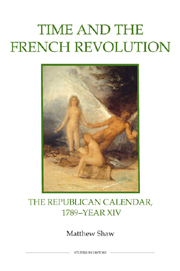Book contents
- Frontmatter
- Contents
- List of illustrations
- Preface
- Miscellaneous Frontmatter
- Acknowledgements
- Abbreviations
- Introduction: writing the history of the republican calendar
- 1 Time and history
- 2 The French republican calendar, 1793–1806: a narrative account
- 3 Cultivating the calendar: the calendar and republican culture in the Year II
- 4 The clash with religion
- 5 Work and rest
- 6 Republican hours
- Conclusion: the legacy of the republican calendar
- APPENDICES
- 1 Timeline of key events, 1788–1806
- 2 The republican calendar: a glossary
- 3 Names of the days of the republican year
- 4 Concordance for the Gregorian and republican calendars
- Bibliography
- Index
6 - Republican hours
Published online by Cambridge University Press: 12 September 2012
- Frontmatter
- Contents
- List of illustrations
- Preface
- Miscellaneous Frontmatter
- Acknowledgements
- Abbreviations
- Introduction: writing the history of the republican calendar
- 1 Time and history
- 2 The French republican calendar, 1793–1806: a narrative account
- 3 Cultivating the calendar: the calendar and republican culture in the Year II
- 4 The clash with religion
- 5 Work and rest
- 6 Republican hours
- Conclusion: the legacy of the republican calendar
- APPENDICES
- 1 Timeline of key events, 1788–1806
- 2 The republican calendar: a glossary
- 3 Names of the days of the republican year
- 4 Concordance for the Gregorian and republican calendars
- Bibliography
- Index
Summary
Of those members of the committee of public safety arrested along with Robespierre in the summer of Year IV, the youngest and perhaps most ideologically-driven was Saint-Just. He also, it seems, paid a particular attention to his appearance. When he was arrested, he was carrying that most republican of fashion accessories, a decimal timepiece made by A. Elyor, a reputed clockmaker in the Galerie de l'Égalité, the republican name for the Palais Royal. What should we make of this? That the most self-consciously ‘Spartan’ of all the Revolutionaries clearly saw the need to adopt the new decimal hours of the Year II may indicate the importance that Jacobins placed on the new system. In this politically-charged time, sporting a decimal watch undoubtedly carried a number of meanings beyond mere fashion. For a high-profile member of the committee of public safety, a decimal watch could suggest several things, including his support for rational innovation and the practical benefits of the application of the Enlightenment thought or his rejection of the ancien régime and the hours of the Catholic day. The metrification of time also suggested a Cartesian concern for regularity and an interest in clinical exactitude: few would deny that these coldly rational characteristics were present in Saint-Just's pronouncements on the need for Terror or his writings on republican institutions. Other well-known republican figures, such as the astronomer Laplace, are also known to have used decimal timepieces (Laplace's watch was adapted with a new dial).
- Type
- Chapter
- Information
- Time and the French RevolutionThe Republican Calendar, 1789-Year XIV, pp. 122 - 144Publisher: Boydell & BrewerPrint publication year: 2011



